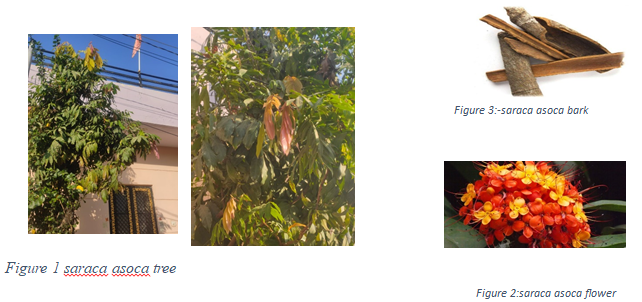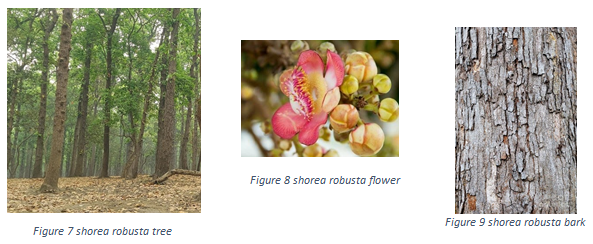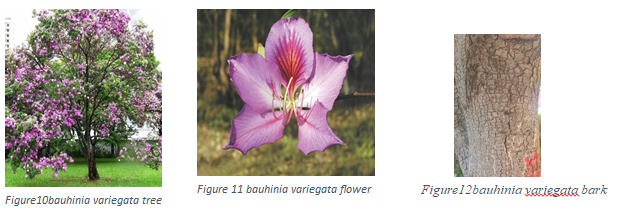Ijraset Journal For Research in Applied Science and Engineering Technology
- Home / Ijraset
- On This Page
- Abstract
- Introduction
- Conclusion
- References
- Copyright
Exploring Saraca Asoca: Importance, Controversy, and Its Botanical Neighbours
Authors: Kirti Mawar, Dr. Chandan Singh, Dr. Rajendra Purvia, Dr. Pragati Lajurkar
DOI Link: https://doi.org/10.22214/ijraset.2025.66262
Certificate: View Certificate
Abstract
Saraca asoca (Ashoka) is a medicinal plant renowned in Ayurvedic medicine for its role in treating various gynecological conditions. Despite its revered status, the plant\'s authenticity has been compromised due to frequent misidentification and substitution with other species such as Shorea robusta, Polyalthia longifolia, and Bauhinia variegata. This review critically examines the controversy arising from these substitutions, which are often driven by morphological similarities and the scarcity of authentic Saraca asoca in certain regions. Through an analysis of existing literature, it is evident that these substitute species lack the specific bioactive compounds that give Saraca asoca its therapeutic properties. Consequently, the use of these substitutes in place of true Saraca asoca can result in diminished efficacy and pose potential safety risks. The findings highlight the pressing need for accurate botanical identification and the implementation of standardized quality control measures to ensure the integrity of herbal medicines. Addressing this issue is crucial not only for preserving the therapeutic value of traditional remedies but also for protecting consumer health. The review concludes that more rigorous research and regulatory oversight are necessary to resolve the ongoing controversies surrounding Saraca asoca.
Introduction
I. INTRODUCTION
The Ashoka tree (Saraca asoca) holds a prominent place in Ayurvedic medicine, celebrated for its therapeutic properties, particularly in treating gynecological disorders. Its name "Ashoka" means "without sorrow," reflecting its historical use in alleviating women's health issues. Despite its revered status in traditional medicine, Ashoka's use is surrounded by controversies related to efficacy, safety, and botanical confusion with other species such as Shal (Shorea robusta), Polyalthia longifolia, and Bauhinia variegata. This review explores the medicinal properties of Ashoka, examines the scientific evidence supporting its use, and addresses the controversies associated with its application.
In general, the reasons for controversy can be enlisted starting from giving the same synonyms/vernacular names to more than one plant, a difference of opinion of authors, documentation defects in manuscripts, causing confusion in identifying the genuine plant. Ashoka trees are not widely accessible, this is why a tree that is identical to it can be placed in a variety of locations in place of this one. Shaal bark is utilised instead of Ashoka bark from Dehradun to Rishikesh. In a similar vein, kanchnar bark is employed in Calcutta. Aashopallav is utilised as an Ashoka plant somewhere in Gujarat.[i]
A. Scientific Classification
Kingdom: Plantae
Division : Magnoliophyta
Class : Magnoliopsida
Order: Fabales
Family : Caesalpinaceae
Genus: Saraca
Species: asoca
The description of Ashoka enlisted in different Ayurvedic literature as follows:
Ashoka description in various Samhita and Nighantu
1) Description in Samhita
Charak Samhita- Vednasthapana[ii], Kasayaskandh[iii]
Sushrut Samhita-Rodhradi gana[iv],Vata vyadhi (Ashoka ghrta)[v]
Astanga hrdaya[vi]- Rodhradi gana ,
Vrinda madhav[vii] - Pradara(ashoka twak kwath)
2) Description in Nighantu
In Dhanvantari Nighantu[viii] :
It is described under amradi varga and is called as Sokanasa, Vicitra, Kar?apuraka, Visoka, Raktaka, Ragi, Citra and Satpad Manjari. Asoka is sweet in taste, sitavirya, cordial, useful for union promoting, and fragrant (flowers). It is used in piles, helminthic infestations, apaci (scrofula), and in all types of wounds.
In Kaiyyadeva Nighantu[ix] :
It is cited under o?adhi varga and is called as Gatasoka, Vitasoka, Visoka, Tamrapallava, Pindipuspa, Hemapuspa, Subhaga, Karnapuraka, Vicitra, Raktaka, Ragi, Ramstavakmanjari, Citrasoka, Sokanasa and Stripadahatidohada.
In Raja Nigha??u [x]:
It is cited under karaviradi varga and is called as Sokanasa, Visoka, Vanjuladruma Madhupuspa, Apasoka, Kankeli, Kelika, Raktapallava, Citra, Vicitra,Karnapuraka, Subhaga, Smaradhivasa, Dosahari, Prapallava, Ragitaru, Hemapuspa, Ramavamanghrighataka, Pindipuspa, Na?a and Pallavadru. Asoka is cooling cardiotonic, and it alleviates pitta, burning, and fatigue. It quells gulma (false abdominal lumps due to wind), colics, and flatulence in the abdomen. It causes worms to proliferate.
In Bhavaprakasa Nighantu[xi] : It is cited under puspa varga and is called as Hemapuspa , Vanjula, Tamrapallava, Kankeli, Pindapuspa, Gandhapuspa and Na?a. It is cold, astringent, bitter, pain-inducing, absorbent, and blood collector. It removes the laxity of the uterus and has some stimulant effects on its endothelium and ovary.it is used in menorrhagia, dysmenorrhoea, leucorrhoea, dysentery, and uterine disorders. Like ergot, it can be used in all types of menorrhagia.
II. DESCRIPTION OF ASHOKA
Saraca asoca-Saraca indica, an evergreen, grows to a height of 7 to 10 meters. The leaves are paripinnate, intrapetiolar, 15-20 cm long, oblong to lanceolate, and fully joined. The bark of this species is warty and irregularly dark brown or nearly black due to rounded or projecting lenticels. Fracture splinting results in a continuous, thin white coating. The apetalous, corymbose, golden orange, and deciduous flowers with petaloid calyxes. They are compressed, elliptical, elongated, and seed shaped.[xii]

III. DESCRIPTION OF DIFFERENT PLANTS USED AS ASHOKA
1) Polyalthia Longifolia: Its magnificent green, willowy, wavy-edged leaves hang from dangling branches that nearly clasp the towering straight stem. The leaves are utilised as temple ornaments in India. The blossoms are tiny and star-like, giving the tree a distinctive hazy appearance due to their pale green colour. useful part-bark and leaves.[xiii]

|
Figure 5 polyalthia longifolia flower |
2) Shorea Robusta: At a very young age, the tree forms a lengthy taproot. Leaves are simple, lustrous, and glabrous, about 10-25 cm long and roughly oval at the base, with the apex tapering into a long point; young leaves are reddish and quickly turn delicate green. Yellowish-white flowers are grouped in huge terminal or axillary racemose panicles.[xiv] Useful Part-Bark and Leaves

3) Bauhinia Variegate: It is a small to medium-sized tree that grows up to 10-12 meters tall and is deciduous during the dry season. The leaves are 10-20 cm obcordate in shape, long and broad, rounded, and bilobed at the base and apex. The flowers are striking, brilliant pink or white, 8-12 cm in diameter, and have five petals. Pollen is elongated, measuring roughly 75 microns in length. The fruit is a seedpod 15-30 cm long with many seeds. When the seedpod reaches maturity, it begins to twist into a helix or corkscrew shape. Useful part-Bark & Flowers[xv]

A. Pharmacological Activity
- Anti Menorrhagic Activity: For ages, the dried bark of Saraca asoca has been used to cure menorrhagia. In cases of uterine diseases, dried bark coupled with flowers was given as a tonic to female patients while also acting as a uterine sedative. Saraca asoca's stem bark has also been used to cure a variety of menstrual-related disorders. An aqueous preparation of the bark prepared from hot water has been provided to females to make the uterine oestrus while avoiding tonic contractions.[xvi]
- Antioxytocic Activity: The plant exhibited oxytocic activity in rat and human uterine preparations, with the estrogen-primed or gravid uterus being more sensitive to the alcoholic extract. Pentolinium bitartrate completely blocked the oxytocic action. The seed extract was found effective against dermatophytic fungi. However, Saraca asoca extracts did not show oxytocic activity in vitro tests on rat uterine preparations. Saraca asoca has previously been tested and found to be inactive.[xvii]
- Anticancer activity: Saraca asoca flowers' anticancer principle showed 50% cytotoxicity (in vitro) in Dalton's lymphoma ascites and Sarcoma-180 tumour cells at concentrations of 38 mug and 54 mug, respectively. It did not affect on normal lymphocytes but had preferential activity on lymphocytes from leukaemia patients. [xviii]
- Anti-inflammatory Activity: The ethanolic extract of Saraca asoca leaves was used to determine anti-inflammatory activity. Saraca asoca leaves showed anti-inflammatory action against Carrageenan-induced paw oedema in mice, making it a viable test for screenng anti-inflammatory properties. Ethanolic extract of Saraca asoca considerably lowers paw oedema (P<0.01). The plant extract, at a level of 200 mg/kg, demonstrated considerable anti-inflammatory action. Compared to 10 mg/kg diclofenac, it inhibited growth in paw volume by 56.95%, but for a shorter duration. [xix]
- Analgesic Activity: Saraca asoca leaf extracts are responsible for analgesic action. The leaf extracts such as petroleum ether, chloroform, methanol, and water were tested for phytoconstituents such as sterols, glycosides, saponins, carbohydrates, alkaloids, flavonoids, tannins, protein, and so on. The analgesic effect of the aforementioned extract was investigated in albino mice using the tail immersion method and the formalin-induced pain method. Petroleum ether, chloroform, methanol, and water extracts have dose-dependent analgesic action. The formalin test is commonly used to correlate analgesic effects to clinical pain. In the early phase of the formalin test, pain emerges owing to the direct activation of the sensory nerve fibres by formalin, but in the late phase pain is caused by inflammatory mediators such as histamine, prostaglandins, serotonin, and bradykinins. [xx]
- Antiulcer Activity: The aqueous suspension of Saraca asoca flowers is used to treat stomach ulcers in albino rats. Saracasin, saracadin, waxy substance, fatty acids, and flavonoids are among the most important constituents of Saraca asoca flowers. So the flowers of Saraca asoca suspension display antiulcer potential efficacy through at least one or more probable pathways, such as suppression of basal gastric secretion, stimulation of mucus secretion, and endogenous gastric mucosal prostaglandin synthesis.[xxi]
- Antidiabetic Activity: The hypoglycemic effect of methanolic bark extracts of Saraca asoca on normal and streptozotocin-induced diabetic rats was studied. The extract demonstrated considerable hypoglycemic action when administered orally at a dose of 400mg/kg.[xxii]
B. Controversies
1) Botanical Misidentification
One of the major controversies surrounding Ashoka involves botanical misidentification. Saraca asoca is often confused with other species such as Shorea robusta, Polyalthia longifolia, and Bauhinia variegata. These misidentifications can lead to inconsistent therapeutic outcomes, as these species do not possess the same medicinal properties as Saraca asoca.
- Shorea Robusta: Known as the Sal tree, Shorea robusta is often mistaken for Ashoka due to similarities in their bark and habitat. However, Shorea robusta lacks the specific phytochemical profile that gives Saraca asoca its medicinal properties. The bark of Shorea Robusta showed comparatively higher phenolic content.(Sulaiman&jinu Krishnan unnithan &Jyoti& Indira)
- Polyalthia Longifolia: Commonly referred to as the false Ashoka tree, Polyalthia longifolia is often confused with Saraca asoca because of its similar appearance. Despite its name, Polyalthia longifolia does not share the same medicinal benefits. The stimulant fractions of saraca asoca acts by liberation of acetylcholine,that of polyalyhia longifolia acts directly on the plain muscle fibre.(Borokar &Pansare2017)
- Bauhinia Variegata: Also known as Kachnar, Bauhinia variegata is another species mistaken for Ashoka due to overlapping geographical distribution and morphological similarities. However, its medicinal uses differ significantly from those of Saraca asoca .The bark of bauhinia variegata used in fever,skin disease and wound healing.(A.k. pandey& Vijayalakshmi ojha & Swati Yadav and Sonu kumar)
2) Efficacy and Safety
The efficacy of Ashoka as a medicinal plant is another point of contention. While traditional practitioners vouch for its benefits based on centuries of use, skeptics argue that many of these claims are anecdotal and lack robust scientific backing. Concerns about the safety of long-term use of Ashoka have also been raised.
The effectiveness of Ashoka in treating gynecological disorders is supported by traditional use and preliminary scientific studies. However, the lack of large-scale, rigorous clinical trials limits the strength of this evidence.
Although Ashoka is generally considered safe when used appropriately, the presence of bioactive compounds necessitates caution. Long-term use and high doses may lead to adverse effects, and there is a need for comprehensive safety studies to establish safe usage guidelines.
3) Sustainability
The high demand for Ashoka in traditional medicine has led to overharvesting, posing a threat to its conservation status. Unsustainable harvesting practices not only endanger the species but also affect the quality and availability of the plant for medicinal use. Overharvesting of Saraca asoca has led to a decline in its population in the wild. Efforts to cultivate Ashoka and promote sustainable harvesting practices are crucial to ensure its long-term availability. Promoting sustainable cultivation and harvesting practices, such as controlled harvesting and replanting initiatives, can help preserve Ashoka for future generations. Additionally, raising awareness about the importance of sustainable use among traditional medicine practitioners and consumers is essential.
IV. RAS GUNA VIRYA VIPAK [xxiii]AND CHEMICAL COMPOSITIONS [xxiv]OF DIFFERENT PLANTS
|
S.N |
Plant name |
Rasa |
Guna |
virya |
vipak |
Chemical composition |
|
1. |
Saraca asoca |
Kashaya, tikta |
Laghu, ruksh |
sheet |
katu |
Tannins,Catechin, Epicatechin,saponins, Leucocyanidine,Procyanidin, Leucopelargonidine, 11’deoxyprocyanidin B,Glycosides,Lyoniside,Nudiposide |
|
2. |
Polyalthia longifolia |
Tikt,Katu |
Laghu, ruksh |
ushna |
katu |
Alkaloids, flavonoids, saponins,O-methylbulbocapnine-N-oxide , polyfothine, N-methylnandigerine-N-oxide, oliveroline-N-oxide, pendulamine A , N-pendulamine B |
|
3. |
Shorea robusta |
Kashaya |
Ruksh |
Sheet |
katu |
Phenolic compounds, tannins, flavonoids, Bergenin, Shoreaphenol, Olenolic acid |
|
4. |
Bauhinia variegata |
Kashaya |
Laghu, ruksh |
Sheet |
katu |
Flavonoids, tannins, glycosides,Lupeol,Naringenin-5,7-dimethylether 4’rhamnoglucoside6, Quercetin,friedelin, Stigmasterol |
V. DISCUSSION
The ras of Saraca asoca is astringent and bitter,virya sheet and vipak katu. plants grown in place of Saraca asoca are like Shorea robusta ,Bauhinia variegata, polyalthia longifolia. They are also almost the same in qualities, Shorea robusta, bauhinia variegata, and saraca asoca have the same rasa and virya, while Polyalthia longifolia does not.Polyalthia's rasa are katu,tikta, and Virya ushna. These plants have distinct therapeutic actions, such as Saraca asoca has vednasthapan action, Bauhinia variegata has gandamalanashak action, Shorea robusta has mutrasanghrniya action, and Polyalthia longifolia has jwarghna action.Their chemical constituents differ from those of saraca asoca, which helps us comprehend their effect.
The chemical constituents catechin and epicatechin distinguish Saraca asoca from Polyalthia longifolia.The phenolic content (reservertol) of Saraca asoca and Shorea robusta differs; Shorea robusta has a higher concentration.The presence of flavonoides and stigmasterol in Bauhinia variegata distinguishes it from Sarca asoca. Hence these plants are taken in place of real Ashoka, but due to the difference in chemical composition of these plants, the medicinal use of real Ashoka cannot be fulfilled. To fulfil the population's ever-increasing requirements and make the most of the available potential gains, it is frequently adulterated with the bark of Polyalthia longifolia,shorea robusta and Bauhinia variegata. It is a tree that exhibits properties of the bark that are comparable to those of S. asoca. The use of these plants brings about a significant decrease in the efficacy of the medications that are manufactured from these, which in turn brings about a compromise in the therapeutic efficacy. Although the barks have macroscopic features similar to those of S. asoca, a comparison of their biochemical and chromatographic properties indicated that they had considerable and substantial variances. Therefore, these techniques can be utilized to determine whether the crude drugs are authentic.
Conclusion
We must emphasize the need for an objective research on the plants mentioned in the Ayurvedic classical literature to link their description to the correct botanical sources applying the principles of Namajnana, Roopajnana, Yuktijnana etc. Therefore proper identification and standardization should be done to solve the controversy, so that physicians can be able to use source plants without any uncertainty on its therapeutic efficacy. Ashoka (Saraca asoca) remains a plant of significant medicinal interest, particularly in the realm of women\'s health. However, addressing the controversies surrounding its use is essential for its integration into modern medical practices. Resolving issues of botanical misidentification, conducting rigorous scientific research to validate its therapeutic claims, and promoting sustainable harvesting practices are crucial steps toward achieving this goal. By bridging the gap between traditional knowledge and modern science, the potential of Ashoka as a valuable medicinal resource can be fully realized.
References
[1] Some Controversial Drugs in Indian Medicine, Dr.Bapalal Vaidya ,Chaukhambha Orientalia,Varanasi,page no.25-31 [2] Charak Samhita of Agnivesh,Pandit Kashinath pandey,Dr.Gorakhnath chturvedi,Chokhamba Bharati Academy,Varanasi.Edition 2017,Sutrasthan,Chapter 04,Page no-96 [3] Charak Samhita of Agnivesh,Pandit Kashinath pandey,Dr.Gorakhnath chturvedi,Chokhamba Bharati Academy,Varanasi.Edition 2017,Viman sthan,Chapter08,Page no-792 [4] Sushrut Samhita,Dr.Ambikadutt shashtri,Chaukhambha Sanskrit Sansthan,Varanasi.Edition-2016, Sutrasthan ,Chapter-38,Page no-184 [5] Sushrut Samhita,Dr.Ambikadutt shashtri,Chaukhambha Sanskrit Sansthan,Varanasi.Edition-2016, Chikitsasthan ,Chapter-04,Page no-35 [6] Astang hrdayam of Srimadvagbhata,Dr.Brahmanand Tripathi,Chaukhamba Sanskrit Pratishtan,Delhi,Edition-2014,Sutrasthan,Chapter-15,Page no-200 [7] Vrndamadhava or Siddha Yoga,Dr.Premvati tewari,Chaukhambha Visvabharati,Varanasi,Edition-2007,Pradar chikitsa,Page no-620 [8] Dhanvantari Nighntu,Aacharya Priyavrat Sharma,Dr.Guruprasad Sharma, Chaukhambha Orientalia,Varanasi,Aamradi Varga,Page no-177 [9] Kaiyadeva Nighntu, Prof.Priyavrata Sharma,Dr.Guruprasad Sharma, Chaukhambha Orientalia,Varanasi, osadhi varg,page no-623 [10] Raj Nighantu,Sri Narhari Pandit By Dr. Satish Chandra Sankhyadhar,Forword by Prof.K.C.Chunekar, Chaukhambha Orientalia,Varanasi,Karviradi Varg,Page no-497 [11] Bhavaprakasa Nighantu(Indian Materica Medica) of Sri Bhavamisra,by Prof.K.C.Chunekar,Chokhamba Bharati Academy,Varanasi,Pushpa Varg,Page no-487 [12] Pradhan P, Joseph L, Gupta V, Chulet R, Arya H, Verma R, Bajpai A. Saraca asoca (Ashoka): a review. Journal of chemical and pharmaceutical research. 2009;1(1):62-71 [13] Thombare Varsha Dattatray, Shamkuwar Prashant Baburao, Chavan Shital Shivaji (2021). A comprehensive review on Polyalthia longifolia. Traditional Medicine Research, 6(2), . [14] Pragati Khare , Kamal Kishore , Dinesh Kumar Sharma(2018),Historical aspects, Medicinal uses, Phytochemistry and Pharmacological review of Bauhinia variegata,Asian Journal of Pharmacy and Pharmacology 2018; 4(5) [15] Sahil Salvi,, Ryan Varghese, Gargi Digholkar, Abha Deshpande,Chinmay Malvankar ,Atmaram ,Pawar,Dileep Kumar, Saraca asoca: A scoping review on the phytoconstituents, bioactives and their therapeutic effects ,German J Pharm Biomaterials [16] Saha JC, Savini EC, Kasinathan S. Ind J Med Res. 1961: 49:130-151. [17] Mathew N, Anitha MG, Bala TSL, Sivakumar SM, Narmadha R, Kalayansundaram M. Paracitol Res. 2009; 104:1017-1025. [18] Nayak S, Sahoo AM, Chakarbarti CK, Haque Ml, Antibacterial study of Saraca indica leaves extract, IJPRD. 2011; 3(3):160-163. [19] Verma A et al. Analgesic activity of various leaf extracts of Saraca indica Linn. Der Pharmacia Lettre. 2010; 2:352-357. [20] Njar VCO, Adesanwo JK, Raji Y, Methyl A. The antiulcer agent of the stem back of Entandrophrarma angolense, Planta Med. 1995; 61:91-92. [21] Preethi F, Fernandes, Jennifer, Pricilla K. Hypoglycemic activity of Saraca asoca Linn barks Journal of Pharmacy Research. 2010; 3(3):491. [22] Dravyaguna vijnana,vol-2,Prof.P.V. Sharma,Chaukhambha Bharati Academy,Varanasi,edition-2022 [23] Quality standards of Indian medicinal plants,medicinal plants division,Indian council of medical research,new delhi,Edition -2018
Copyright
Copyright © 2025 Kirti Mawar, Dr. Chandan Singh, Dr. Rajendra Purvia, Dr. Pragati Lajurkar. This is an open access article distributed under the Creative Commons Attribution License, which permits unrestricted use, distribution, and reproduction in any medium, provided the original work is properly cited.

Download Paper
Paper Id : IJRASET66262
Publish Date : 2025-01-03
ISSN : 2321-9653
Publisher Name : IJRASET
DOI Link : Click Here
 Submit Paper Online
Submit Paper Online

